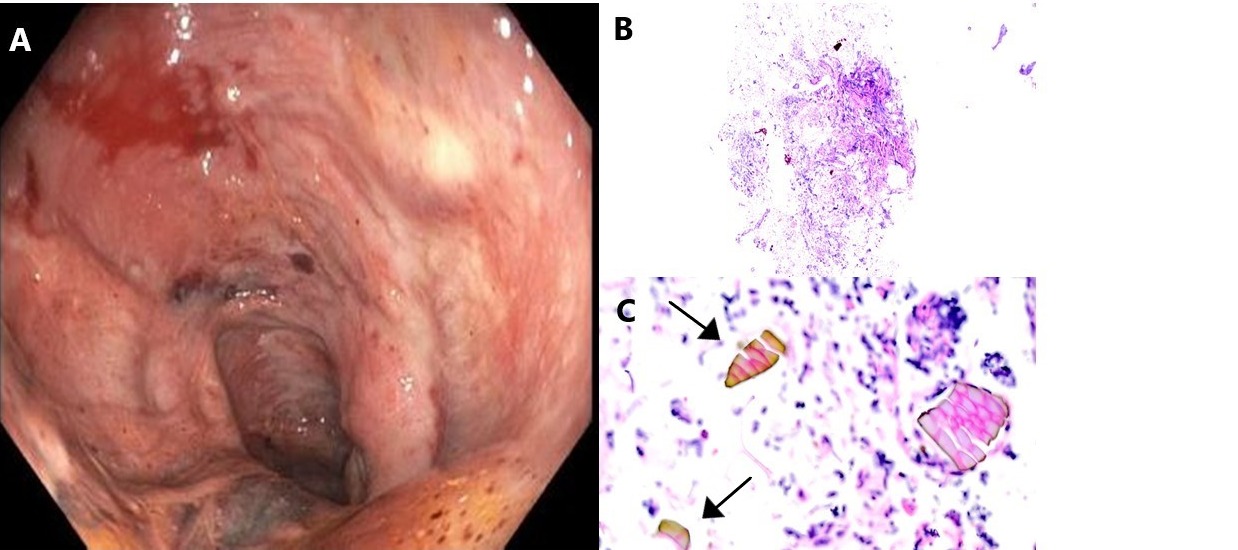Back


Poster Session B - Monday Morning
Category: Colon
B0161 - Sevelamer-Induced Colitis: Phos-Friend or Phos-Foe?
Monday, October 24, 2022
10:00 AM – 12:00 PM ET
Location: Crown Ballroom

Has Audio

Ameya Deshmukh, DO
Saint Louis University School of Medicine
St. Louis, MO
Presenting Author(s)
Ameya Deshmukh, DO1, Zarir Ahmed, DO2, Thomas Fay, MD1, Daniel Miller, MD, PhD1, Michael Giacaman, MD1
1Saint Louis University School of Medicine, St. Louis, MO; 2Saint Louis University, St. Louis, MO
Introduction: Sevelamer use is phosphate binder used in patients with chronic kidney disease (CKD) and end-stage renal disease (ESRD) and is associated with gastrointestinal (GI) side effects such as vomiting, nausea and diarrhea. However, phosphate binders have also been reported to cause colonic ischemia. Here, we describe a case of sevelamer-induced colitis.
Case Description/Methods: A 66-year-old male with a history of ESRD and chronic hypotension presented to the emergency room with one episode of dark bloody stools for the past day. He was afebrile, HR of 68 and a BP of 93/46. He was started on IV fluids, PPIs and was kept NPO. An upper endoscopy was unrevealing for significant pathology. Colonoscopy revealed friable, erythematous mucosa in the ascending colon and extensive ulcerations from the transverse to descending colon. Biopsies were taken. Histology exhibited colonic mucosa with areas of necrotic debris with acute inflammation and ulceration. However, the epithelial necrosis was not of vascular ischemic origin. The necro-inflammatory debris present was described as curved crystalloids with an irregular ‘fish-scale’ pattern. These histological findings are consistent with sevelamer-induced colitis. The patient’s sevelamer was discontinued and his fludrocortisone and midodrine were continued for blood pressure support. He received dialysis and was discharged back to his facility.
Discussion: Initially there was concern for ischemic colitis given his history of ESRD, PVD, chronic hypotension. However, upon medication review, we noted he was taking sevelamer.
Colonic ischemia can generally be classified into right colonic ischemia and ischemic colitis. Right colonic ischemia generally involves the superior mesenteric artery and is frequently caused by an occlusive arterial event such as an embolus or thrombosis. In contrast, ischemic colitis is involves the inferior mesenteric artery and is more frequently due a low flow state with no identifiable occlusive event.
Many medications have also been associated with self-limited ischemic colitis. Sevelamer is a phosphate binder that binds phosphate within the GI tract. Based on available literature, only an association between the development of colitis and sevelamer use has been made with resolution of the symptoms after sevelamer discontinuation. The exact mechanism of injury from the sevelamer crystals is unknown.
This case illustrates a potential mechanism for drug induced colonic ischemia, i.e., crystal deposition within the colonic mucosa.

Disclosures:
Ameya Deshmukh, DO1, Zarir Ahmed, DO2, Thomas Fay, MD1, Daniel Miller, MD, PhD1, Michael Giacaman, MD1. B0161 - Sevelamer-Induced Colitis: Phos-Friend or Phos-Foe?, ACG 2022 Annual Scientific Meeting Abstracts. Charlotte, NC: American College of Gastroenterology.
1Saint Louis University School of Medicine, St. Louis, MO; 2Saint Louis University, St. Louis, MO
Introduction: Sevelamer use is phosphate binder used in patients with chronic kidney disease (CKD) and end-stage renal disease (ESRD) and is associated with gastrointestinal (GI) side effects such as vomiting, nausea and diarrhea. However, phosphate binders have also been reported to cause colonic ischemia. Here, we describe a case of sevelamer-induced colitis.
Case Description/Methods: A 66-year-old male with a history of ESRD and chronic hypotension presented to the emergency room with one episode of dark bloody stools for the past day. He was afebrile, HR of 68 and a BP of 93/46. He was started on IV fluids, PPIs and was kept NPO. An upper endoscopy was unrevealing for significant pathology. Colonoscopy revealed friable, erythematous mucosa in the ascending colon and extensive ulcerations from the transverse to descending colon. Biopsies were taken. Histology exhibited colonic mucosa with areas of necrotic debris with acute inflammation and ulceration. However, the epithelial necrosis was not of vascular ischemic origin. The necro-inflammatory debris present was described as curved crystalloids with an irregular ‘fish-scale’ pattern. These histological findings are consistent with sevelamer-induced colitis. The patient’s sevelamer was discontinued and his fludrocortisone and midodrine were continued for blood pressure support. He received dialysis and was discharged back to his facility.
Discussion: Initially there was concern for ischemic colitis given his history of ESRD, PVD, chronic hypotension. However, upon medication review, we noted he was taking sevelamer.
Colonic ischemia can generally be classified into right colonic ischemia and ischemic colitis. Right colonic ischemia generally involves the superior mesenteric artery and is frequently caused by an occlusive arterial event such as an embolus or thrombosis. In contrast, ischemic colitis is involves the inferior mesenteric artery and is more frequently due a low flow state with no identifiable occlusive event.
Many medications have also been associated with self-limited ischemic colitis. Sevelamer is a phosphate binder that binds phosphate within the GI tract. Based on available literature, only an association between the development of colitis and sevelamer use has been made with resolution of the symptoms after sevelamer discontinuation. The exact mechanism of injury from the sevelamer crystals is unknown.
This case illustrates a potential mechanism for drug induced colonic ischemia, i.e., crystal deposition within the colonic mucosa.

Figure: Figure 1 A-C: Mucosal injury seen during colonoscopy (A). Pathology slide displaying sevelamer crystals found on biopsy (B-C).
Disclosures:
Ameya Deshmukh indicated no relevant financial relationships.
Zarir Ahmed indicated no relevant financial relationships.
Thomas Fay indicated no relevant financial relationships.
Daniel Miller indicated no relevant financial relationships.
Michael Giacaman indicated no relevant financial relationships.
Ameya Deshmukh, DO1, Zarir Ahmed, DO2, Thomas Fay, MD1, Daniel Miller, MD, PhD1, Michael Giacaman, MD1. B0161 - Sevelamer-Induced Colitis: Phos-Friend or Phos-Foe?, ACG 2022 Annual Scientific Meeting Abstracts. Charlotte, NC: American College of Gastroenterology.
